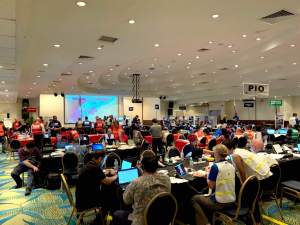Communications is a vital component within any crisis or emergency response. After all, how will interested stakeholders know what you are doing to respond unless you tell them? But in some crisis drills and live responses I’ve been part of, too often Joint Information Center (JIC) activities, i.e. communications, are hived off from the wider response and viewed through a narrow, tactical lens.
Although the task of drafting press releases, issuing alerts on social media and organizing press conferences is very important, the JIC has a wider role to play in guiding the strategic direction of the Incident Command System (ICS) during a fast-moving emergency.
Here are four practical tips for how Joint Information Center staff can help ensure that they are better integrated within the Incident Command System:
The move to virtual working has meant that some agencies participate virtually in the JIC during an emergency response. Sometimes a hybrid approach can’t be avoided - but where possible, it’s always best for a physical JIC war room to be established within the Incident Command Post (ICP) and in proximity to the Emergency Operations Centre (EOC).
Not only does this help with the speed of decision-making and information sharing, but it also seems far easier for in-person teams to establish an effective ‘battle rhythm’, as well as more consistency in terms of the information they’re working from and the messaging they’re sharing with stakeholders.
Command leaders need actionable intelligence to help guide decision-making, but too often in drills and live responses monitoring reports compiled by the JIC can tend to be overly descriptive. Establish with response leaders at the outset what kind of intelligence they need you to provide and ensure you tailor your approach accordingly. Although it’s useful for response leaders to know which media titles are actively reporting on an incident, developments related to the immediate impacts of the emergency (e.g. relative concerns, traffic disruption) that are emerging on social media are more helpful in enabling leaders to build their situational awareness of the incident.
Remember too that communicators are the experts when it comes to the local or regional stakeholder ecosystem. The best PIOs and JICs proactively map and prioritise the stakeholders that will need to be managed during a response at the outset, and provide guidance to command leaders on the best way to do this in terms of:

Due to the fast-moving nature of a live response, interactions within the JIC and between the JIC, other teams/functions and response leaders can tend to be very ad hoc and reactive. It’s nearly as important to establish a regular, proactive means for internal comms and information sharing as it is to communicate publicly. Sharing regular Situation Reports (SitReps) can be an effective way of keeping everyone up to date.
The JIC is a key point of interaction and coordination between the various responding agencies. As such, PIOs and other JIC personnel have a role to play in ensuring that the different response players remain aligned and joined up in their response efforts. This helps ensure that the JIC communicates with one voice as far as possible. This can be done by:
The best JICs manage to foster a collaborative dynamic, so try to be a helpful partner by also sharing useful comms collateral such as pictures or video content with response partners that they can easily include within their content to help foster an open and constructive working dynamic within the team.
Download our useful resources: Sitrep example and Stakeholder grid example